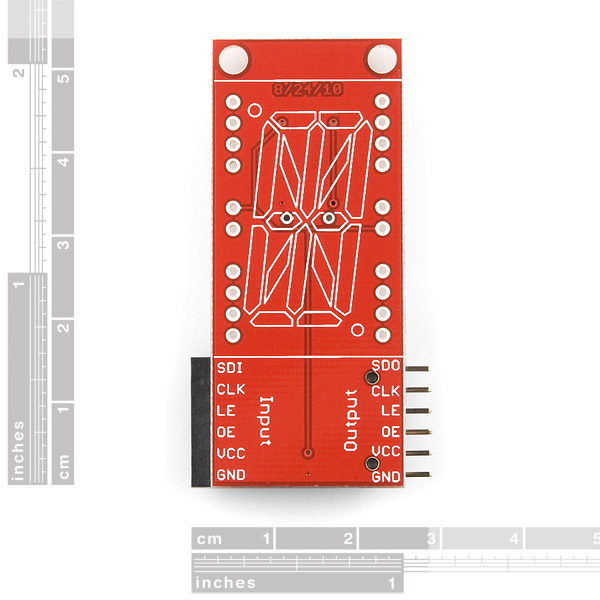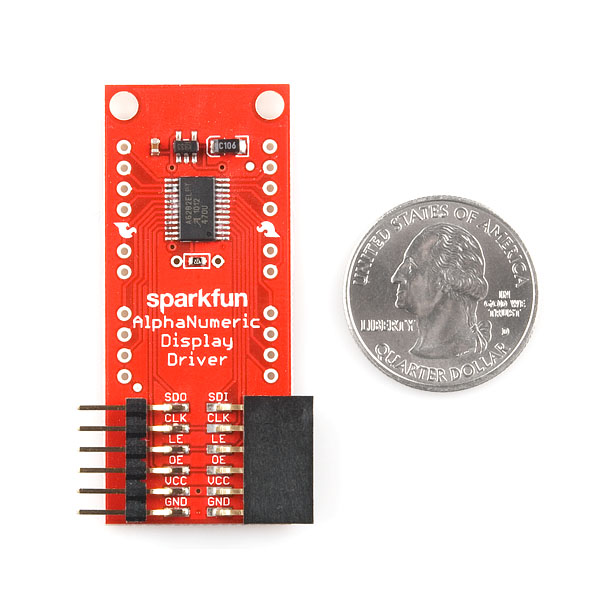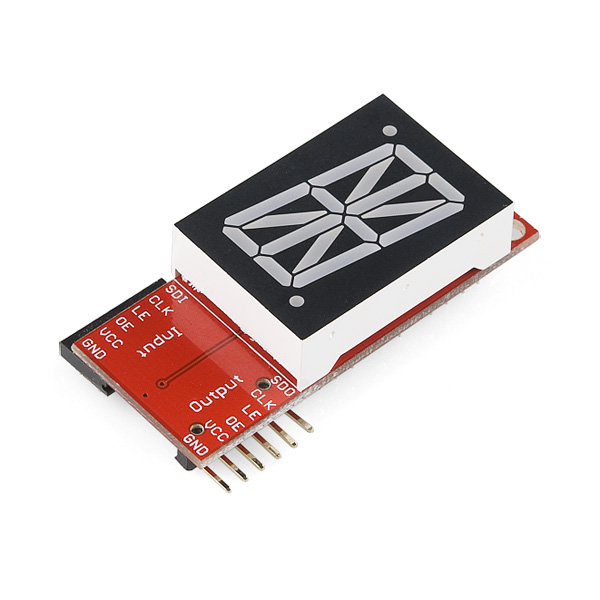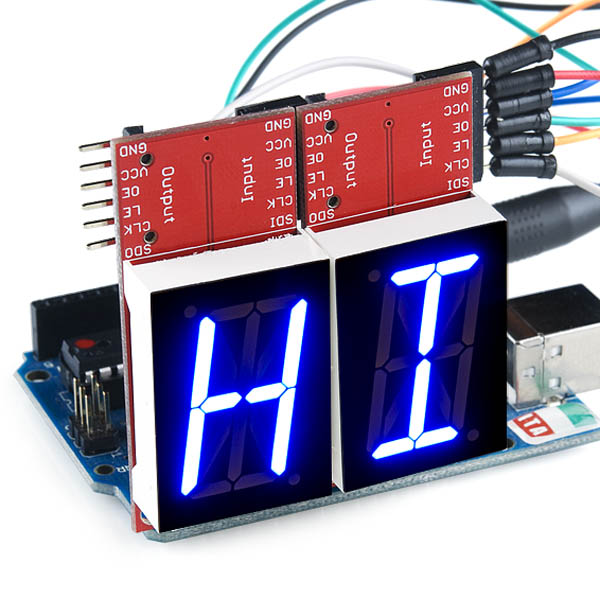SparkFun Serial Alphanumeric Display Driver
The SparkFun Serial Alphanumeric Display Driver allows you to communicate with alphanumeric displays over a simple SPI interface. Based on the A6282 IC, these boards work well with all of our alphanumeric displays and we have even provided a library listed below.
You can daisy-chain as many displays as you would like to create scrolling messages. Each board has both input and output headers that connect to each other. All you need to do is define the number of displays and your message. Check the example code below.
Note: This product includes only the carrier board. You will need to provide your own alphanumeric display. Check the related products below for ones that will work.
SparkFun Serial Alphanumeric Display Driver Product Help and Resources
Alphanumeric GPS Wall Clock
January 26, 2015
This is a GPS controlled clock - a clock you truly never have to set! Using GPS and some formulas, we figure out what day of the week and if we are in or out of daylight savings time.
Core Skill: Soldering
This skill defines how difficult the soldering is on a particular product. It might be a couple simple solder joints, or require special reflow tools.
Skill Level: Rookie - The number of pins increases, and you will have to determine polarity of components and some of the components might be a bit trickier or close together. You might need solder wick or flux.
See all skill levels
Core Skill: Programming
If a board needs code or communicates somehow, you're going to need to know how to program or interface with it. The programming skill is all about communication and code.
Skill Level: Competent - The toolchain for programming is a bit more complex and will examples may not be explicitly provided for you. You will be required to have a fundamental knowledge of programming and be required to provide your own code. You may need to modify existing libraries or code to work with your specific hardware. Sensor and hardware interfaces will be SPI or I2C.
See all skill levels
Core Skill: Electrical Prototyping
If it requires power, you need to know how much, what all the pins do, and how to hook it up. You may need to reference datasheets, schematics, and know the ins and outs of electronics.
Skill Level: Rookie - You may be required to know a bit more about the component, such as orientation, or how to hook it up, in addition to power requirements. You will need to understand polarized components.
See all skill levels
Comments
Looking for answers to technical questions?
We welcome your comments and suggestions below. However, if you are looking for solutions to technical questions please see our Technical Assistance page.
Customer Reviews
No reviews yet.







SERIAL ALPHANUMERIC DISPLAY DRIVER!
Y U NO CHEAPER!?
Sparkfun, can you put this code in github or something?
I posted a link to an updated version below, but I'd love to submit a pull request, so you can be the maintainers.
https://github.com/dubhunter/AlphaNumeric_Driver
Reaaaaaaallly delayed reply, but we do have a repo now! Link is above.
This is a brilliant idea! But at the 10+ quantity level, a 20-character display would cost over $300. :-( I wish there was a more cost-effective alternative.
The lower cost alternative is to just use two 8-bit shift registers for each display. They cost only a bunch of shift registers since there are only 16 segments to power. You can even use the tutorial in the 8-bit shift register product page (http://www.sparkfun.com/products/733), but extend it to all 16 segments.
Oops: ... cost only $1.50, for $3 per display...
I actually bought a bunch of 8-bit shift registers, got them working, and then realized I don't have the time to do that much wiring. Sure they're great if you've got a board for them, but I would rather spend the extra cash here and save time.
looking for 41 com 10103 ro hs are some thing else that will don the job thank you
Why is this so expensive? The Allegro driver is only USD 1.13 in hundreds...
If I am building a multi character display using my own board, do I need to have a voltage regulator for each driver chip or is one good for the whole board?
A6282 is pretty much at end of life. Guess it time to look for a new replacement.
One year later and no sign of end-of-life on the Allegro site. Just the QFN package has been discontinued.
How do you fix the compile issue with wiring.h in Adruino 1.0.5? I tried "wiring_private.h", and "Arduino.h" as suggested in some Arduino posts, however none worked.
Never mind. Just saw the link below. https://github.com/dubhunter/AlphaNumeric_Driver
Can I buy A6282 IC single version?
Raspberry Pi version of the lib based on dubhunter's updated code: https://github.com/swemaniac/raspberrypi-alphanumeric-driver
I'm not sure why the 3.3V regulator is needed. The datasheet for the A6282 says the abs. max. supply voltage is 5.5V. Anyone have an explanation for this?
wow, this was ridiculously easy to get up and running! two points to keep in mind for newbies: the arduino library only works with the previous version of the software (ie. not arduino 1.0.1, must be 0023 or earlier) and if you are using a arduino mega, change the pin declarations in the example file to the following:
int SDIpin = 51; //MOSI int CLKpin = 52; //SCK int LEpin = 53; //SS int OEpin = 49;
my a6282 is only glowing upper half leds of seven segement display...:( can someone tell me what this shit is....
These are for 16 segment AlphaNumeric displays, not 7 segment
When I try to compile the example sketch it tells me its missing the wiring.h library. What am I doing wrong?
Ack! Are you using Arduino 1.0? I'm guessing the library is probably not compatible with that.
I need to update it to work with Arduino 1.0. Until then, though, it shouldn't have a problem compiling with an older version of Arduino. Check the "Previous IDE Versions" section here. 0023 should work.
Here is an updated version for 1.0 https://github.com/dubhunter/AlphaNumeric_Driver
Hi folks I have 5 of these working very nicely as a display connected directly to my arduino UNO project. I would like to use an xbee module to allow me to duplicate the display remotely.
I assume it's not as simple as just connecting pins to the xbee and that I'll have to do some conversion either by code or using an adapter.
I am new to programming so simple solution / explanation would be great.
Is it necessary to run the arduino on 3.3 V also? Since Vdd on the serial alpanumeric board is 3.3 V and according the datasheet from A6282 the logic input levels (SDI CLk etc) may not exceed Vdd + or - 0.3 V.
One of the two I bought had bad solder joints on the connectors. It seemed to work ok by itself most of the time, but when the two were plugged together that one wouldn't work. I spent a futile day trying to figure out what was wrong with my code before finally turning it over and finding out that the bottom half of both connectors had no solder. :D Thirty seconds with the iron and it works as well as the other one - code was fine all along.
Vcc should be >5Vdc. If you get bright segments in the top middle and bottom of the display and the rest look dim, you aren't giving the driver enough voltage. 7.5vdc works nice!
I have 4 of these with the red 1" alphanumeric displays and they work great! I love that I only have to use 6 wires and it shows up so much better from a distance than an LCD screen would.
All of the functions work exactly like they are supposed to.
The only thing I can't figure out is how to use the "#define FLIPDISPLAY" to flip the characters over. The README in the Arduino Library link says to define it before you include the library but it doesn't do anything no matter where I put it. Any advice?
You need to define that FLIPDISPLAY before the '#include AlphaNumeric_Driver.h' statement because it has a #ifndef statement there to flip the display.
Can it be programmed to sink vs. source current? I have a large quantity of common-cathode displays that are the right size.
OK looks like it has current-sink outputs so CA only. Too bad.<br />
<br />
How about a MAX6955 board for 8 CC 16-segment displays? Sure, the chip costs more but you only need one.
Thanks for mentioning the 6955. I just got done wiring up a Maxim 6969 to a 16 segment display and wish I had the 6955 instead.
I don't know what it is about alphanumerics, but I just think they rock. Cooler than 7-segments and easier to use than a graphic display. Anything that aids in their use gets a thumbs-up from me.